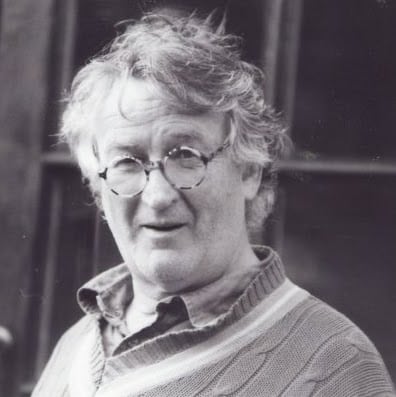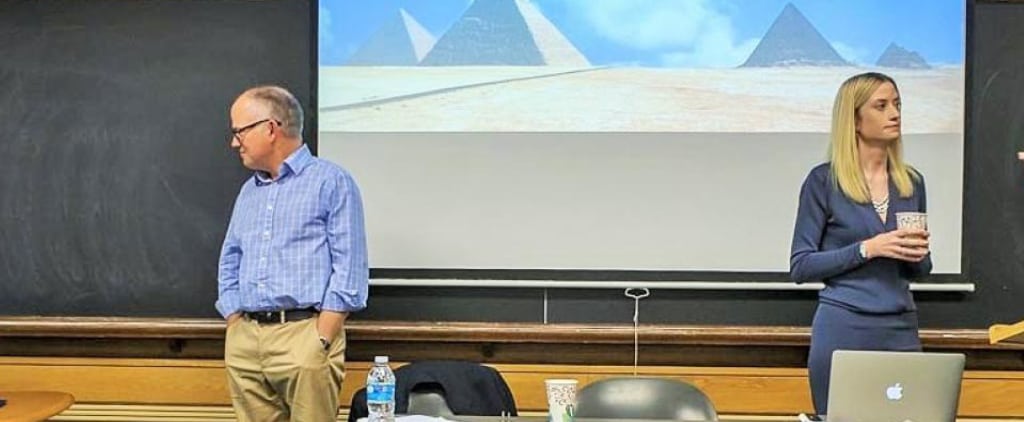Should we risk lives to save cultural heritage?
[dropcap style=”font-size:100px;color:#992211;]O[/dropcap]n Tuesday 17th July 2018 Professor Derek Matravers gave his inaugural lecture, ‘Heritage in War: Protecting Cultural Property and Human Harm.’
The lecture served as an introduction to an Arts and Humanities Research Council three year research project, ‘Cultural Heritage in War.’ The project is being hosted by The Open University and the Stockholm Centre for the Ethics of War and Peace and co-directed by Matravers (Open University) and Professor Helen Frowe (Stockholm University) – see phtograph above.
The two views
Matravers opened by giving us two views. The first has it that no artefact, of whatever worth, is comparable to the loss of a single human life. For the opposing view Matravers cited Harold Nicolson, the British diplomat, who had something to the effect that he would lay down his own life to save the Mona Lisa; and that he would surrender the lives of his two sons to save St Mark’s Square in Venice. (Quite frankly, I wouldn’t deliver a single Italian for the painting and the piazza, let alone the lives of three Englishmen.)
Many interesting thoughts tumbled in and around these opposing views. The fact that cultural objects are what make up our lives and the lives of others begins to intrude upon questions of personal identity. Who I am depends, to a certain extent, upon the world into which I am interwoven.
Wherein lies value?
Recruiting the Austrian art historian, Alois Riegl, Matravers suggested that age in and of itself confers worth on certain irreplaceable objects; citing new work by American Aesthetician, Carol Korsmeyer, who noted that queues of people line up to get a sight of the Gettisburgh Address, signed by Abraham Lincoln.
Authenticity is another property that purportedly conveys the value of objects. See, for instance, the piece on Charles Darwin’s manuscript page from On the Origin of the Species, that sold for £490,000 at Sothebys earlier this month.
Even Immanuel Kant can be fetched on stage to give support. In his ground-breaking Critique of Judgement, the Prussian philosopher tells us of the disappointment we undergo when, having enjoyed the song of a nightingale, we find out it was an impudent boy whistling.
Further thoughts
Of course, even if we agree that during conflict works of art should be protected, we still have to argue as to what level of protection they should be given. And, like much ethical theory concerned with war, there has to be some thought given to the possible harm to non-combatants as well as those involved in the military.
All of this produced much food for further thought; and it is to be hoped that the Centre and its project will flourish and provide an arena in which policy makers can come to reasoned conclusions.
Good consequences can emerge from war damage

St Lukes, Liverpool, a.k.a. ‘the bombed out church’ with its new congregation
Leaving Milton Keynes
The journey from Walton Hall back to Milton Keynes Central Station took me through orange brick semi-detatched housing. The sun was lowering in the sky and added more glow to the orange brick under a pale blue-grey sky. The light grey lamp-posts and bus shelters made the whole scene filmic. I had Velvet Underground singing ‘Pale Blue Eyes’ running through my mind; and had that sickening feeling, as if I had left a lover’s bed to which I could not return.
Talk of war and the destruction of art is a gloomy affair. The low sun over Milton Keynes was quite surreal; and put me in mind of John Betcheman’s lines on Slough,
Come friendly bombs and fall on Slough!
It isn’t fit for humans now
See also, Derek Matravers at OU
Helen Frowe at Stockholm University

Ed studied painting at the Slade School of Fine Art and later wrote his PhD in Philosophy at UCL. He has written extensively on the visual arts and is presently writing a book on everyday aesthetics. He is an elected member of the International Association of Art Critics (AICA). He taught at University of Westminster and at University of Kent and he continues to make art.




















